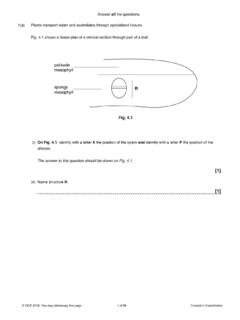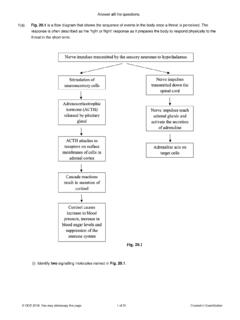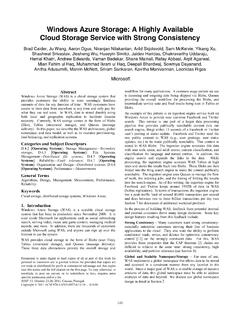Transcription of 6.3 Manipulating Genomes - Calder Learning Trust
1 Answer all the questions. 1(a). DNA fragments can be separated using electrophoresis. Fig. shows the result of electrophoresis of several DNA samples. (i) Describe how DNA can be visualised after electrophoresis has been completed. [2]. (ii) Place a cross (X) on Fig. to indicate the position of a fragment of DNA with a mass greater than the DNA. band labelled Y. [1]. OCR 2018. You may photocopy this page. 1 of 38 Created in ExamBuilder (b). (i) Mixtures of proteins can also be separated by electrophoresis. Proteins are heated before being placed in the electrophoresis gel. The gel contains a substance called SDS, which has a negative charge. SDS binds to proteins. Suggest why proteins are heated before being placed in the electrophoresis gel. [1]. (ii) Suggest why the binding of SDS to proteins is necessary for protein electrophoresis.
2 [2]. 2. Which statement correctly describes a difference between somatic and germ line gene therapy? A Germ line therapy involves the use of liposomes; somatic therapy involves use of viral vectors. B Somatic therapy can target specific tissues in need of treatment, germ line therapy cannot. C Somatic therapy is most successful when targeting single gene defects, but germ line therapy can target multiple defects. D Long term success is theoretically more likely with somatic cell therapy than germ line therapy. Your answer [1]. OCR 2018. You may photocopy this page. 2 of 38 Created in ExamBuilder 3. An Iron Age farm was excavated by archaeologists. Some DNA was recovered from the tooth of an animal thought to be a type of domesticated milk cow. A farmer keeps rare breed cows similar to those farmed on the Iron Age farm.
3 DNA from the cows was obtained. What technique would you plan to use, to compare digested and amplified fragments from the two DNA. samples? [1]. OCR 2018. You may photocopy this page. 3 of 38 Created in ExamBuilder 4. Tissue traces from a crime scene often need to be identified. DNA from the tissue is amplified' by the polymerase chain reaction (PCR) to get samples large enough for further analysis. Modern PCR technique uses DNA polymerase from the bacterium Thermus aquaticus. Why is this enzyme chosen? [2]. OCR 2018. You may photocopy this page. 4 of 38 Created in ExamBuilder 5(a). The European corn borer moth, Ostrinia nubilalis, is a pest of agriculture. Its larvae develop inside maize stems and eat the contents, weakening the stems so that the plants collapse. The bacterium Bacillus thuringiensis ( Bt') produces a protein that poisons the larvae of moths and butterflies.
4 This protein can be isolated from cultures of Bt and packaged in fluids to be sprayed on the surface of plants. The gene coding for the toxic protein has also been isolated. It has been incorporated into a genetically modified strain of maize called Bt corn. This makes the plant tissues poisonous to the corn borer moth. Consider the statement: Genetically modified plants and animals should be classed as new species'. Outline one experiment or investigation that would provide evidence to support or contradict the statement. [3]. (b). A farmer wants to increase the yield of maize. A friend recommends planting genetically-modified Bt corn as it would be more effective against European corn borer larvae rather than spraying unmodified corn with Bt toxin. Which method would you recommend to the farmer? Justify your answer.
5 [1]. OCR 2018. You may photocopy this page. 5 of 38 Created in ExamBuilder (c). * Some students investigated the different ways of protecting maize plants against the corn borer moth. In each of three separate but close-together square plots, in the same field, they planted several hundred maize seedlings. Plot A: untreated (control). Plot B: sprayed daily with Bt toxin. Plot C: the seedlings planted were genetically modified Bt corn. On the first day of each week, one student would walk around the edge of a plot and count the number of maize plants that had collapsed in that plot. Each plot had a student responsible for counting. The results are shown in Table Number of maize plants collapsed since the last weekly count Week number Plot A Plot B Plot C. 1 0 0 1. 2 0 0 0. 3 18 22 21. 4 0 0 0. 5 5 1 0. 6 14 11 12. 7 5 2 1.
6 8 12 0 1. 9 17 1 0. 10 30 6 0. 11 32 13 1. 12 41 17 0. 13 38 26 1. 14 47 31 1. 15 50 44 2. 16 49 47 0. Table The students' tutor raised a number of concerns about the investigation. In summary: The methods were not a valid test of what was being investigated. The results may not be accurate. OCR 2018. You may photocopy this page. 6 of 38 Created in ExamBuilder Some variables were not controlled. Explain why these concerns are justified and suggest improvements to the investigation. [6]. OCR 2018. You may photocopy this page. 7 of 38 Created in ExamBuilder 6(a). In order to sequence the whole genome of an organism it may be necessary to sequence billions of nucleotides. The human genome is approximately billion nucleotides long. Sequencing DNA requires a series of steps. Place the following steps in the correct sequence.
7 The first and last ones have been done for you. A place sections in order by matching overlapping regions B cut DNA into sections of varying length C sequence short sections of DNA. D amplify the DNA (create many copies). E extract samples of DNA from cells E _____ _____ _____ A. [2]. The development of high-throughput sequencing techniques has enabled whole Genomes to be sequenced more rapidly. Table compares a number of DNA sequencing techniques. Technique Rate of sequencing (Mb Maximum length of Typical number of errors 1. day ) nucleotide chain per 100 000 nucleotides sequenced Sanger (chain 6 1000 5. termination technique). Roche pyrosequencing 750 500 50. SOLiD 5000 50 500. Helicos 5000 32 1000. Table (b). The protein coded for in a gene is 200 amino acids in length. How many errors could be expected in the exons of the sequenced gene when using the least accurate sequencing technique shown in Table Answer_ _ _ _ _ _ _ _ _ _ _ _ _ _ _ _ _ _ _ _ _ _ _ _ _ _ _ _ [2].
8 OCR 2018. You may photocopy this page. 8 of 38 Created in ExamBuilder (c). Roche pyrosequencing relies on building a chain of nucleotides against a template. It involves the following steps: Nucleotides are washed over the template in a specific order. When the correct nucleotide is present it joins the new chain. The addition of a nucleotide to the chain releases energy. The energy is used to activate a protein called luciferin. Light released by luciferin is detected. If two identical nucleotides are added together then the intensity of the light emitted is doubled. Fig. shows a readout from a pyrosequencing machine. Read off the sequence of bases in the length of DNA. [1]. OCR 2018. You may photocopy this page. 9 of 38 Created in ExamBuilder (d). (i) A portion of a gene was sequenced from two members of the same family suspected of having a genetic disease.
9 The sequences are shown below: What proportion of the sequence is different? Answer = _ _ _ _ _ _ _ _ _ _ _ _ _ _ _ _ _ _ _ _ _ _ _ _ _ _ _ _ [2]. (ii) To identify an allele that causes a genetic disease it must be sequenced accurately so that differences from the healthy allele are clear. Using the information in Table decide which technique is best to use when sequencing a human gene that causes a genetic disease. Explain your choice. [2]. (iii) Suggest how the interdisciplinary field of bioinformatics may be useful in determining whether a newly- sequenced allele causes a genetic disease. [2]. OCR 2018. You may photocopy this page. 10 of 38 Created in ExamBuilder (e). DNA profiling uses techniques to separate lengths of DNA to produce a profile that is unique to each individual. Explain why only selected sections of non-coding DNA are used when profiling a human.
10 [3]. OCR 2018. You may photocopy this page. 11 of 38 Created in ExamBuilder 7(a). Gene sequencing is an important technique in molecular biology. Fig. shows part of a computerised graph obtained from an automated gene sequencing machine. The section of the DNA molecule represented in Fig. is from base position 117 (on the left of the graph). to base position 137 (on the right of the graph). The bases in the DNA sequence are labelled with four different coloured fluorescent dyes. The identities of some of the bases (117 to 119 inclusive and 129 to 137 inclusive) are indicated below the graph. Use Fig. to identify the order of bases from positions 120 to 128. [1]. OCR 2018. You may photocopy this page. 12 of 38 Created in ExamBuilder (b). To produce the type of graph shown in Fig. , the automated gene sequencing machine needs to be loaded with the following: the DNA to be sequenced short primer sequences specific to the DNA to be sequenced many normal DNA nucleotides some chain-terminating DNA nucleotides labelled with coloured dyes the enzyme Taq polymerase.















